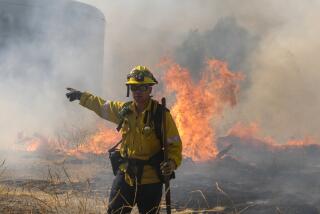Flood Insurance Would Cover What Standard Policies Often Leave Out in the Rain
Q: I keep hearing ads on the radio for flood insurance because of the coming El Nino storms this winter. Can you explain what this insurance is and whether I really need it?
--M.D.
A: If you believe the most dire predictions, the El Nino weather pattern developing in the Pacific could produce one of the wettest winters this region has experienced in 50 years. Even less dramatic forecasts signal an extremely wet and wild winter.
The insurance industry wants you to know this and to understand that most homeowners and renters--even those who consider themselves fully insured--are not covered for flood damage under standard policies.
Here are the basic insurance facts:
* A standard homeowners or renters insurance policy does not cover many types of flood or flood-related damage.
* Flood insurance, which is available through the Federal Insurance Administration, can be purchased separately through your agent. These policies offer coverage of up to $250,000 in structural damage and $100,000 in damage to a home’s contents. Further, this insurance is available only if the community in which you live participates in the National Flood Insurance Program. (To find out if your community is a member, ask your homeowners insurance agent or check with your local public works department.)
* Rates depend on an area’s flood potential, the age of a home and its method of construction. In an area of low to moderate risk for flooding, the price range for $100,000 in structure coverage and $60,000 in contents coverage (with a $500 deductible) ranges from a low of about $360 annually for both to a high of about $440.
Let’s go through the above points individually.
A standard homeowners policy does not cover what is known as “rising water” damage--problems caused by water that accumulates on the ground after falling from the sky. Rather, the policies usually cover damage caused by rainwater as it falls. You may consider this a technicality, but insurers don’t.
Here’s how the distinction works:
Damage caused by rainwater that gets into your house because a storm blew a hole in your roof, window or wall is typically covered by the standard homeowners policy. (In general--and you should check your policy and contact your agent to be sure--structural damage from fallen trees and other wind-related damage is usually covered by a homeowners policy as well.)
However, most standard homeowners policies exclude damage resulting from earth movement such as mudslides. Also, most policies do not cover damage from a leaky roof. The rule in this case is that unless a roof is damaged “externally” by the storm, damage to the contents of the structure is not covered by the homeowners policy.
Flood insurance, on the other hand, covers damage from rising water, such as flooding levees, rivers, dam basins or other water that has collected on the ground before it damages your property. So if you get insurance for both structure and contents, any damage to walls, carpets, furniture and belongings that is caused by water or mud rushing into your home or welling up in your basement is covered. In addition, flood insurance also covers erosion caused by water washing against your home’s foundation.
Flood coverage can be purchased along with standard homeowners insurance. If your agent doesn’t write flood insurance, look for another property-casualty agent who does. It does not matter which agent writes the policy, because all policies are provided by and backed by the federal government, which sets the rates.
You can also purchase flood insurance directly from the National Flood Insurance Program by calling (800) 427-4661, a toll-free line that is answered 24 hours a day. It generally takes 30 days from the time an application is received until the time a policy becomes effective, making it crucial for consumers who think they’ll need the insurance to act before the rains start falling.
Renters should check their insurance policies to see if they are covered for flood damage; few policies cover floods directly. However, if your belongings are damaged by water leaking through a roof, regardless of whether the roof is in good repair, you should be covered, because tenants are not responsible for roof repair. However, if water seeps through the floor, tenants’ belongings are unlikely to be covered without separate flood insurance on an apartment’s contents.
By the way, most comprehensive auto policies cover storm-related damage to your vehicle. Check your policy to be sure. But unless you carry only the minimum liability insurance required by the state, you are probably protected if your car is trapped in a flood or otherwise damaged in a storm. If you are financing the purchase of your car, you probably have comprehensive auto insurance.
For more information about flood insurance and the expected El Nino storms, send a self-addressed, stamped envelope to Western Insurance Information Service, 3530 Wilshire Blvd., Suite 1610, Los Angeles, CA 90010. You will be sent the pamphlet “El Nino Facts and Tips.”
*
Carla Lazzareschi cannot answer mail individually but will respond in this column to financial questions of general interest. Write to Money Talk, Business Section, Los Angeles Times, Times Mirror Square, Los Angeles, CA 90053. Or send e-mail to carla.lazzareschi@latimes.com
More to Read
Sign up for Essential California
The most important California stories and recommendations in your inbox every morning.
You may occasionally receive promotional content from the Los Angeles Times.









